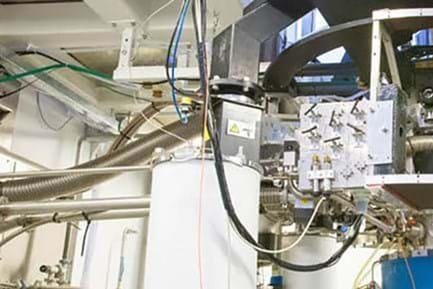
Researchers cooled superfluid helium-3 to about one-ten thousandth of a degree from absolute zero inside this rotating refrigerator. Inside this superfluid, the researchers created two time crystals and and brought them to touch.
Photo by Mikko Raskinen/Aalto University
June 2 (UPI) -- Physicists seemed to bend the laws of physics by linking two time crystals together for the first time in a new study, showing progress for their potential use in quantum computing.
Time crystals are similar to normal crystals except for one unusual property where their atoms exist in a perpetual state of regular motion without an external push, according to ScienceAlert. In normal crystals, atoms are arranged in a fixed, three-dimensional structure, like the atomic lattice of a diamond, and won't move without an external push.
Nobel Laureate Frank Wilczek first theorized time crystals in 2012, but they weren't identified and confirmed by physicists until 2016.
The physicists from Britain and Finland created two time crystals, long believed to be impossible because their perpetual motion appeared to defy the laws of physics, together in a two-level system, the new study published in Nature Communications on Thursday shows.
"Everybody knows that perpetual motion machines are impossible," lead author Samuli Autti of Lancaster University in Britain said in a news release. "However, in quantum physics perpetual motion is OK as long as we keep our eyes closed. By sneaking through this crack we can make time crystals."
"It turns out putting two of them together works beautifully, even if time crystals should not exist in the first place," Autti added. "And we already know they also exist at room temperature."
The two-level system is a basic part of a quantum computer, so time crystals could be used to build quantum devices
Researchers created the two time crystals and brought them to touch in superfluid helium-3 cooled to about one-ten thousandth of a degree of absolute zero in a rotating refrigerator, and then watched them interact.
When they touched each other, they exchanged magnons, which affected the oscillation of the time crystals, creating a single system with the option of functioning in two separate states, according to ScienceAlert.
The experiment is the next step in potentially harnessing time crystals for quantum information processing following the first observation of the interaction between two time crystals, published in Nature Materials two years ago, ScienceAlert noted.
June 2 (UPI) -- Physicists seemed to bend the laws of physics by linking two time crystals together for the first time in a new study, showing progress for their potential use in quantum computing.
Time crystals are similar to normal crystals except for one unusual property where their atoms exist in a perpetual state of regular motion without an external push, according to ScienceAlert. In normal crystals, atoms are arranged in a fixed, three-dimensional structure, like the atomic lattice of a diamond, and won't move without an external push.
Nobel Laureate Frank Wilczek first theorized time crystals in 2012, but they weren't identified and confirmed by physicists until 2016.
The physicists from Britain and Finland created two time crystals, long believed to be impossible because their perpetual motion appeared to defy the laws of physics, together in a two-level system, the new study published in Nature Communications on Thursday shows.
"Everybody knows that perpetual motion machines are impossible," lead author Samuli Autti of Lancaster University in Britain said in a news release. "However, in quantum physics perpetual motion is OK as long as we keep our eyes closed. By sneaking through this crack we can make time crystals."
"It turns out putting two of them together works beautifully, even if time crystals should not exist in the first place," Autti added. "And we already know they also exist at room temperature."
The two-level system is a basic part of a quantum computer, so time crystals could be used to build quantum devices
Researchers created the two time crystals and brought them to touch in superfluid helium-3 cooled to about one-ten thousandth of a degree of absolute zero in a rotating refrigerator, and then watched them interact.
When they touched each other, they exchanged magnons, which affected the oscillation of the time crystals, creating a single system with the option of functioning in two separate states, according to ScienceAlert.
The experiment is the next step in potentially harnessing time crystals for quantum information processing following the first observation of the interaction between two time crystals, published in Nature Materials two years ago, ScienceAlert noted.
No comments:
Post a Comment